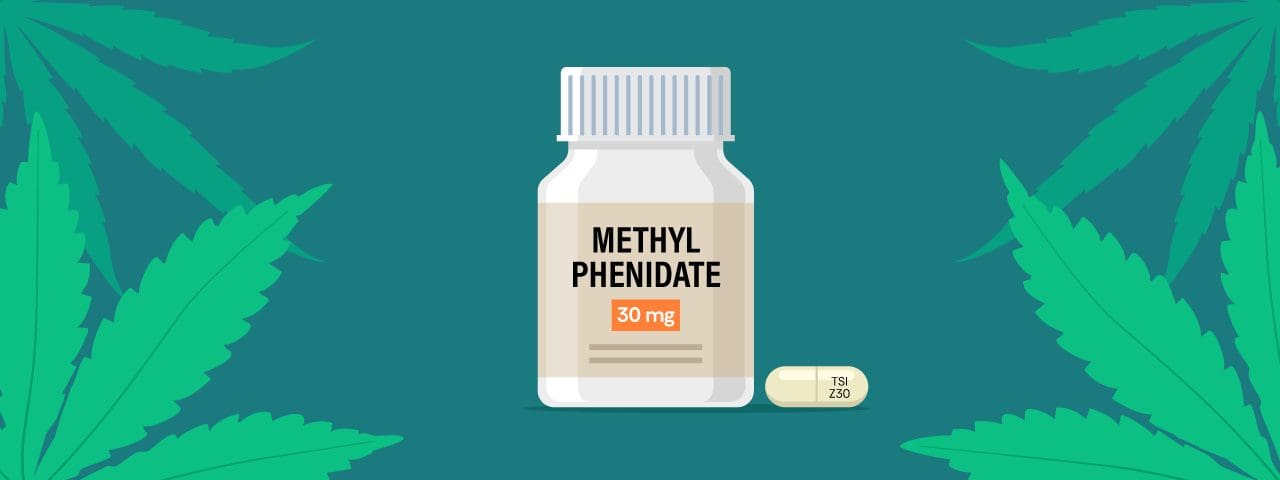Is it safe to mix ibuprofen and weed?
3 min read



Key takeaways
Mixing cannabis (weed) with ibuprofen is generally low-risk when both are taken as directed, but cannabis can slow how quickly your liver breaks down ibuprofen, potentially increasing side effects like dizziness or liver strain. Both may help inflammation and pain, but start with recommended doses and talk with a doctor if you have concerns.
Many people use cannabis to help with inflammation. But combining it with ibuprofen — an over-the-counter anti-inflammatory medication — may, in rare cases, cause side effects.
If you plan to use cannabis and ibuprofen together, it’s important to know how they might interact with each other to manage your symptoms safely.
What is ibuprofen?
Ibuprofen belongs to a category of medications called non-steroidal anti-inflammatory drugs (NSAIDs). Like other NSAIDs, ibuprofen is used to:
- Relieve pain
- Reduce inflammation
- Lower fever
Advil is the most popular brand name for ibuprofen. Others include:
- Motrin
- Motrin IB
How does ibuprofen work?
Ibuprofen lowers the amount of inflammation-causing fatty acids called prostaglandins in your body. In turn, this reduces inflammation symptoms like:
- Pain
- Swelling
- Redness
- Fever
When taken as directed, ibuprofen is generally safe for healthy people. But taking more than the recommended dosage, or taking it too frequently, can cause side effects, including:
- Liver damage
- Kidney damage
- Damage to the stomach lining and esophagus
- Increased risk of heart attack or stroke
- Headaches
- Dizziness
- Blurred vision
- Upset stomach
To minimize these risks, take the recommended dose, and don’t take ibuprofen for more than 3 days in a row without your doctor’s approval.
Wondering how to use ibuprofen with cannabis?
Get a personalized care plan from a provider at Leafwell!
- Product recommendations
- Dosing and daily use tips
- Flags for medication interactions

Is it safe to mix weed and ibuprofen?

The risks of combining cannabis and ibuprofen are generally minimal. However, taking high doses of them together increases certain risks.
Cannabis lowers enzymes in your liver that break down many medications, including ibuprofen. So, mixing cannabis with ibuprofen may prolong the effects of ibuprofen in your body or cause you to have too much in your system. This can lead to a higher risk of side effects like dizziness and liver damage.
Can I take CBD and ibuprofen?
Cannabidiol (CBD) is a compound that’s found in cannabis. It’s nonintoxicating and may help with:
- Anxiety
- Pain
- Sleep
- Inflammation
CBD is one of several compounds in cannabis that lowers liver enzymes which break down ibuprofen and other medications. Taking CBD with ibuprofen may make ibuprofen last longer in your body, increasing your risk of experiencing side effects.
Benefits of using cannabis with ibuprofen
Taking ibuprofen and cannabis together can also have some benefits:
- May enhance inflammation relief: Both substances can relieve inflammation. Taking them together in moderation may help with symptoms like pain and swelling.
- May reduce some cannabis side effects: One animal study suggests that ibuprofen might reduce cannabis’s negative effects on memory, but more research is needed to confirm this effect.
- May lower your ibuprofen intake: When taken in combination, cannabis’s anti-inflammatory properties may allow you to achieve relief with a lower dose of ibuprofen.
- May be effective against some types of skin cancer: One study found that combining NSAIDs like ibuprofen with CBD kills some types of skin cancer cells.
How to take ibuprofen and weed
To lower the risk of side effects when combining ibuprofen and cannabis, follow these safety tips:
- Dose as directed: Take the recommended dosages of both cannabis and ibuprofen to minimize side effects. If your doctor suggests that you take a higher dose of ibuprofen than what’s suggested on the label, ask them for more guidance on combining it with cannabis.
- Consider your other medications: If you take additional medications, ask your doctor if it’s safe to combine them with cannabis and ibuprofen.
Wondering how to use ibuprofen with cannabis?
Get a personalized care plan from a provider at Leafwell!
- Product recommendations
- Dosing and daily use tips
- Flags for medication interactions

The takeaway: Mixing ibuprofen and cannabis might be safe when taken as directed
Mixing cannabis with ibuprofen is generally low-risk, as long as you take both in their recommended dosage amounts.
Combining them might even be helpful, since both cannabis and ibuprofen can lower inflammation to help with pain and swelling.
If you have any concerns about mixing cannabis and ibuprofen, ask your doctor or a Leafwell provider for personal guidance.
Resources
- Activation of peripheral cannabinoid receptors synergizes the effect of systemic ibuprofen in a pain model in rat. https://www.mdpi.com/1424-8247/15/8/910
- An interaction between warfarin and cannabidiol, a case report. https://www.sciencedirect.com/science/article/pii/S2213323217301184
- An overview of clinical pharmacology of ibuprofen. https://pmc.ncbi.nlm.nih.gov/articles/PMC3191627/
- Cannabidiol and its combinations with nonsteroidal anti-inflammatory drugs induce apoptosis and inhibit activation of NF-κB signaling in vulvar squamous cell carcinoma. https://www.mdpi.com/1420-3049/27/24/8779
- Cannabinoid metabolites as inhibitors of major hepatic CYP450 enzymes, with implications for cannabis-drug interactions. https://dmd.aspetjournals.org/article/S0090-9556(24)08016-4/fulltext
- Δ9-THC-caused synaptic and memory impairments are mediated through COX-2 signaling. https://www.cell.com/cell/fulltext/S0092-8674(13)01360-3
- Medical cannabis activity against inflammation: Active compounds and modes of action. https://pmc.ncbi.nlm.nih.gov/articles/PMC9124761/
Get Your Medical Card
Connect with a licensed physician online in minutes.
Larger purchase limits Access to higher potency strains Save up to 40% on product taxes Enhanced legal protection
Frequently asked questions
Learn more about combining ibuprofen and cannabis from these FAQ answers.


